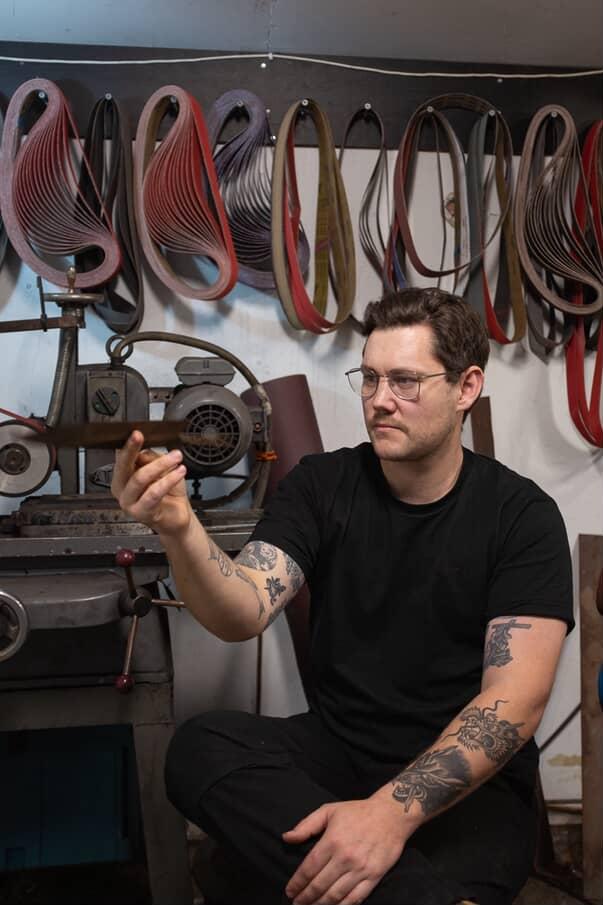
This week’s interview features Lucas Brown from Melbourne Australia. I met Lucas a few years back and have always appreciated his style, and once I had the opportunity to experience how his work performs, I loved it even more. I truly love finding out how makers came to make, and to create the tools that bring me so much inspiration.
What sparked your interest in knives?
I remember being introduced to King Arthur at an early age by a close family friend. I think the concept of Excalibur really ignited a deep appreciation for the significance of ‘the tool’ in me. There is such a strong, primitive, and human connection to the bladed tool inside people that I think comes from our evolution alongside the blade. People’s eyes light up when you hand them a good knife.
From there I had another family friend who taught me how to, very basically, sharpen knives. I got rather obsessed with sharpening. I was probably 12 years old when I first got some pocket money to sharpen an old set of Mundial knives.
What inspired you to do this and how did you learn?
I had always wanted to make knives and swords. I remember just being obsessed with knights and samurai – and their swords. One day my best friend and I watched a Tommy Lee and Benicio Del Toro film called The Hunted. During the film one of the characters makes a very primitive knife. I think at that time we were probably watching a lot of Bruce Lee movies and running around at night acting like ninjas. We made some really crap knives and then I made some slightly less crap knives by grinding old chisels on a bench grinder and etching them in hydrochloric acid that for some reason I had access to as a 13 year old.
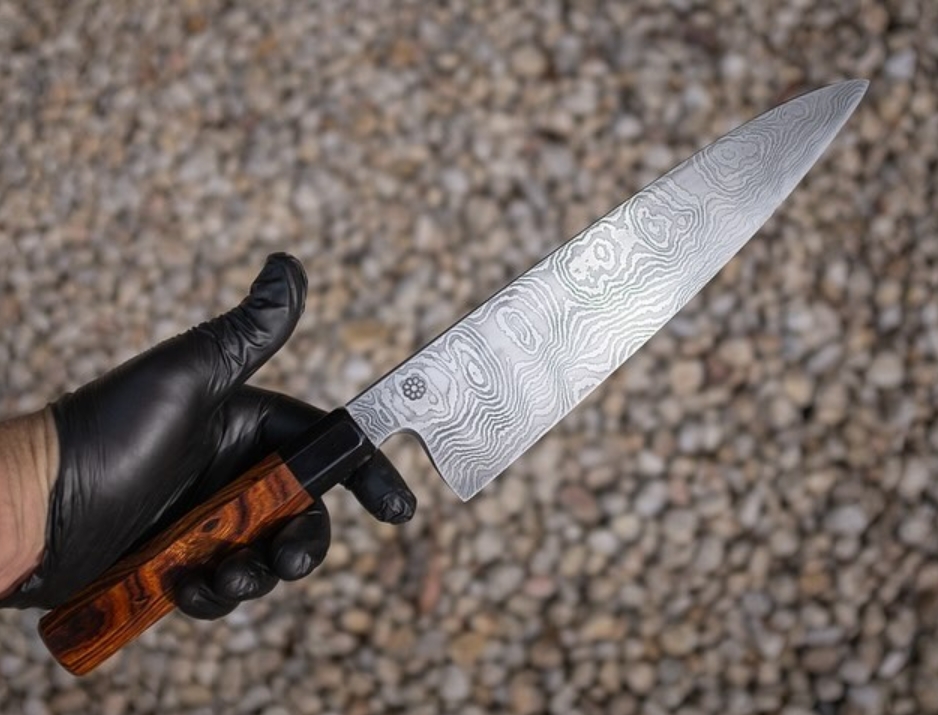
When did you start making knives, and what did you make your first knife with?
I made my first ‘knife’ around 13-14 years old from an old chisel. The heat treatment was likely ruined by my grinding and I have no idea where it ended up.
My first proper knife was slightly before COVID hit. I had just quit drinking and was working in the film and advertising industry as a freelancer. During that time I had a lot of energy, interest and passion that wasn’t being directed anywhere in between freelance gigs and exercise.
I had made a trip to Japan and bought a Masamoto gyuto and a santoku. I felt like I had finally glimpsed a world of steel that I had imagined as a kid. Samurai swords that could cut through a silk cloth became kitchen knives that could cut through paper towel.
One day I was talking to someone about how I had always wanted to make ‘proper’ kitchen knives but had never had the tools or time to do it. I realised at that moment that I could just get my laptop out, buy some steel and figure it out. So I did it. I got my laptop out, Googled something like “Knifemaking Steel”, and bought some 1084 and then poured myself into figuring it out. After about 5 years I think I’ve figured out about 2% of it all.
How do you think you background has affected your knife making?
Much more from working in the camera department than the production side of that world.
Some of the simple photographic theories like the rule of thirds are always guiding principles in both my photography of my knives, and ratios in knives.
Do you have a favorite knife you made, tell me about it?
No. I think one of the reasons I was able to start selling knives full-time so quickly after I began making them is because I obsess over them and I’m very hard on myself. Most of the time when I’m making a knife it’s my obsessive nature fighting the harshest critic I will ever meet so by the time I’m done I’ve poured enough of myself into it that I’m just relieved it’s finished and I’m excited for the opportunity to do it better next time. I’ve reached a point now that I’ve got enough control over those two aspects of myself that I can make a knife that is very close to the best I can make at that time. If I had to pick a favourite it’s probably the petty that I made for my girlfriend’s birthday. It was forged from a bar of damascus/pattern-welded steel that Rob (the 9) forged and gave to me. It’s the knife we use the most and has such an aggressive etch and grind that it can go months without sharpening and it just plows through anything.
What is the most important aspect of a well-made knife?
The human element. You can go and order a technically perfect knife from Amazon right now. The bevels will all be perfect. The steel will be perfectly suitable for the majority of users. You can throw it in the dishwasher and hit bones with it. But it’s never going to make a connection with you, it’s never going to be precious. You’re never going to pick it up and feel that wave of sentimentality, or have guests over who use it and smile with satisfaction. I want a tool that has been made by hand, that has been tested and touched and tuned by hand. I finish all of my knives and handles by hand, by touch and sound and sight. Technology has advanced so far but it’s always the human element that is most valuable because it is inimitable.
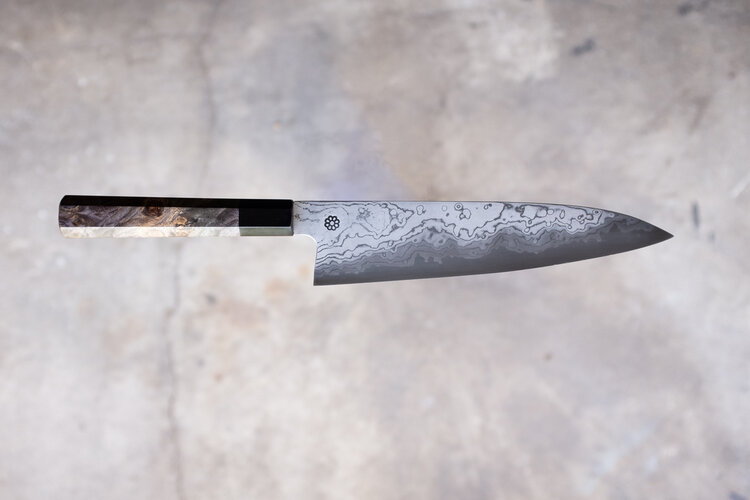
What keeps you going?
Recognising that my knives are important to a lot of people. I’ve made knives for birthdays, weddings, engagement presents, or just someone getting a tax return and buying an expensive knife. They’re out there being used, enjoyed and part of our story. Sometimes it’s just a message from a customer or a post online from someone who has one of my knives and love it.
Biggest struggle?
Balancing perfectionism, reality, my day job and my sanity.
What kinds of knives do you make?
Knives that IKEA will never be able to copy.
Who helped you early on?
I pestered Rob from The 9 probably more than anyone else and he thankfully never blocked me.
Jeff Steele from Black Lotus was also unbelievably generous with his time and when he decided to sell his machinery he sold it to me for an unbelievably cheap price. It was more of an inheritance than an estate sale. All of my early laminate work was forged at his shop, with his machinery, gas, and his time. There are a lot of people who have helped me, so I always try and pay it forward.
Who are your influences?
The first knives that really made me chase the forged geometry that I work with nowadays were from Will Catcheside. There is just no other way to make these knives with a crazy taper out the handle than to forge them. Seeing Will’s work really solidified that knowledge and lit the path to where I want to go.
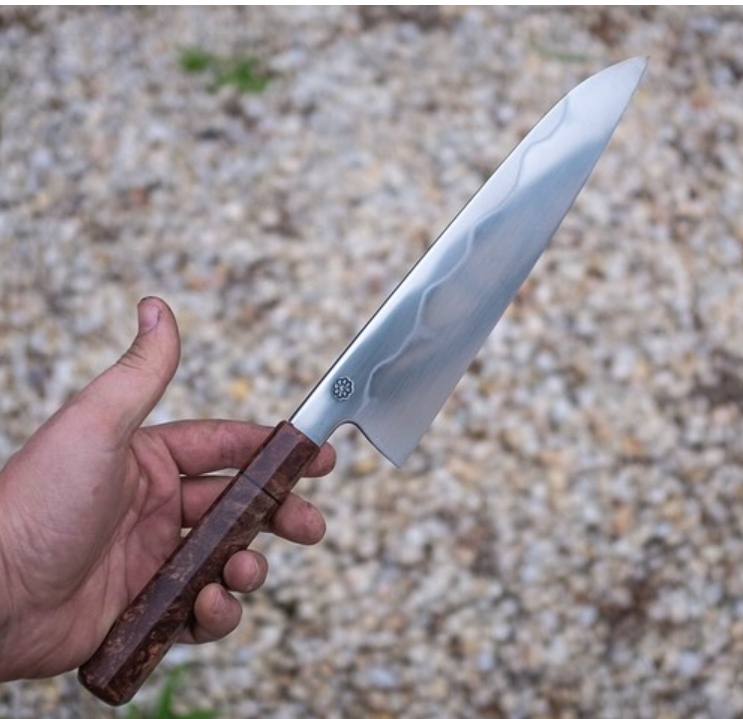
What other knife makers out there impress you these days? Do you take inspiration from anyone else in the field?
Some of the work that our Aussie Maker Gang are doing week-in-week-out blows my mind. Will Newham, Brook Turner, and Adamas Forge (to name a few) are making such clean, organic, technically tight work every single week that I wonder why people even buy my stuff. I’m also always keeping in mind what Lee at Migoto Cutlery would think of my finishes and how much time it takes to get my work stone-finished, so that keeps my practicality in check.
Outside of Australia, Prince Works Forge is the best Western maker to blend art theory and knifemaking that I have ever seen. He is operating on another wavelength. Shoichi Hashimoto has such a unique and clear vision that is incredibly organic, whimsical and free whilst also being so dark and gnarly. I love his work.
Any specific breakthroughs or revelations in your knife making journey?
So many! There are so many tiers to this game that unless you’re making breakthroughs every few weeks, you’re not pushing yourself or asking the right questions.
What is the perfect knife?
The perfect knife is the one that you reach for every time.
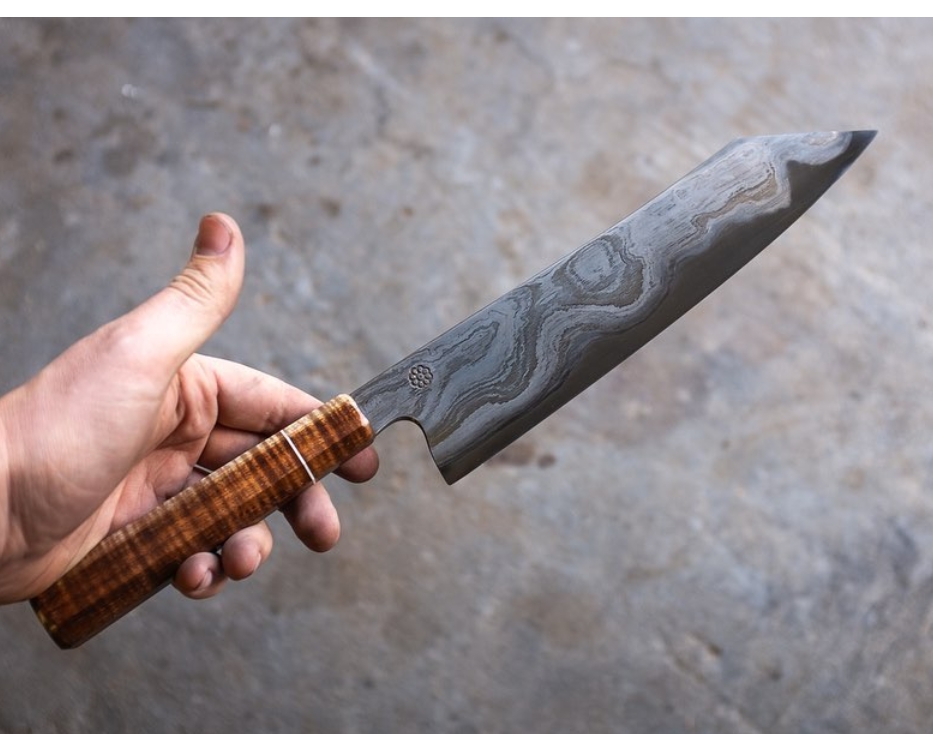
How do you approach knife testing?
Once I’m getting close to final geometry I can really start to feel when I’m getting my grind thin enough. An edge that flexes when you put pressure on it with your nail is where a kitchen knife generally needs to be.
Whilst I do have micrometers to check some things about geometry it always comes down to feel and test cutting. A bag of carrots lets me know where the blade is hanging up and where it needs more work.
How do you develop a design, select a steel, and fine-tune a heat treatment?
These days I’m really enjoying the higher alloyed carbon steels like Apex Ultra in a san mai construction. They stay incredibly rigid even at very thin grinds, with thin core steels and soft cladding.
I don’t think steel choice is the biggest factor in a knife, in fact I think it’s probably in the top 5 but it’s never what makes a knife perform well. The right steel, for the right knife, in the right design is the goal.
Thankfully I bought a Paragon electric kiln before COVID blew prices up, so heat treatment is very straightforward. I follow the knife making patron saint, Dr. Larrin Thomas.
Do you have a favorite steel, tell me about it?
I’m loving Apex Ultra. It allows me to forge super thin san mai blades without the whole thing becoming too flexible. I can take the blade to very thin geometry before it starts becoming difficult to maintain a straight edge.
How has the knife world changed since you started?
The kids these days are crazy. I think Toma Fenes is young enough to almost be my son and he’s doing unbelievable work.
What’s up next for you? Any exciting new projects to tell us about?
Finishing my carpentry apprenticeship. Hopefully finding a bit more spare time for knife work. Maybe some collabs in the very near future too.
For more information and examples of his work check out his website http://www.northsideknives.com or his Instagram https://www.instagram.com/northside_knives/
Leave a Reply